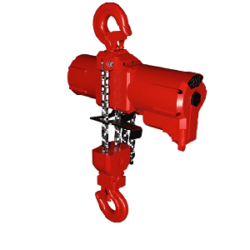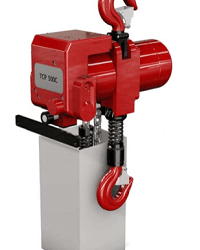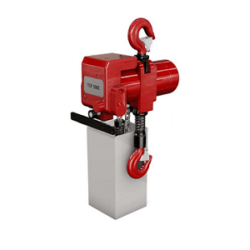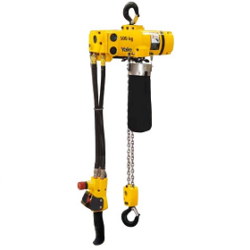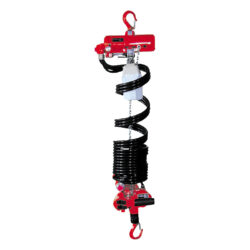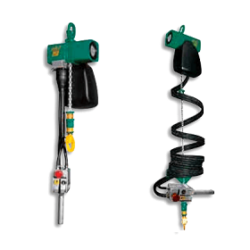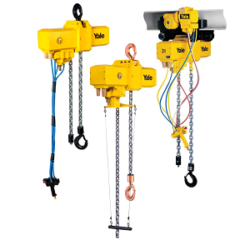Air Hoists / Pneumatic Hoist
Our range of air hoists come in a range of lifting capacities from key manufacturers, for example the Red Rooster air hoist, J.D.Neuhaus air hoists and Yale hoists. Find out more about pneumatic hoists below as well as all the technical details for each model on their own respective pages.
What is an Air Hoist?
These hoists, sometimes called pneumatic hoists use pneumatic air systems to operate instead of electrical power. Pneumatics is a branch of engineering which uses compressed air. So an air compressor unit sucks in atmospheric air and usually removes the naturally occurring moisture from it. Consequently the dry air is then pushed through pipes to power the air chain hoist.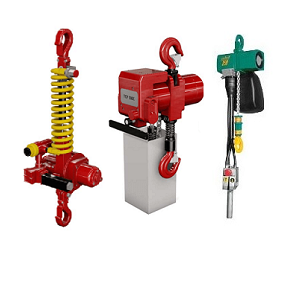
Where can Air Hoists be used?
Handy, flexible and universally deployable, these hoists make the ideal tool for lifting and handling and manufacturing applications. Commonly utilised in many industries including assembly lines, aircraft construction, shipyards and engineering. Pneumatic hoists can also be used in areas which could be deemed hazardous to use electric hoists. Such places could include power plants, chemical plants, paint shops, oil refineries, foundries, mines and oil storage facilities.What are the Advantages of Air Hoists?
- An air chain hoist typically has duty cycles of 100%. Consequently there is no need for a rest period as minimal heat is produced due to the air power.
- The simplistic design of these pneumatic hoists use cylinders and other components, with easy operation using on-off control functions.
- Low maintenance and long life operation due to minimal components is a key benefit to pneumatic hoists.
- Resistant to dirt and dust ingression; Impervious to heat, vapours, high temperatures and humidity.
- Less likely to experience shock damage due to the use of compressed air.
- Very low fire risk
- Hoists commonly incorporate an overload device for additional safety.
- Light in weight – up to 40-50% lighter than similar electric hoists.
- Cleaner to operate with low environmental impact.
- Braking systems incorporated.
- Can be used in hazardous environments
Air Hoists Available
Here are the top branded pneumatic air hoists that we can supply
Red Rooster Air Hoists
Red Rooster Air Hoists are synonymous with their bright red colour, robust design and likewise their high lifting capacities. One of the UK’s leading manufacturers of air powered lifting hoists Red Rooster are a popular brand.
All hoist parts are manufactured in Europe or Japan to high standards under ISO 9001:2008 quality control systems. R.R. hoists conform to all EC and machinery directives and the European standard for hoisting systems BS EN 14492-2. All R.R. air hoists incorporate name plates indicating the serial number for traceability of the hoist.
Other information includes the safe working load, the model, year of manufacture and manufacturers contact details. Most importantly this should remain intact and visible at all times. These hoists are issued with standard certification including an EC declaration of conformity. Also a thorough examination certificate to show it is safe to use and an ATEX certificate if applicable. Likewise other certification may be available on request. If the ATEX rating has been increase a further plate will be added.
One of the main benefits to a R.R. air hoist is that they are easy to operate and control. They are also simple to maintain and there are an abundance of spare parts available. So worn out or broken components can be replaced without the cost of replacing the whole hoist.
These Air Hoists have many safety features which include top and bottom travel limiters, and a load limiter for overload protection. Disc brake failsafe and an emergency stop button on pendant control models are other safety features. All hoists have a safety factor rating of 5:1.
J.D.Neuhaus Air Hoists
J.D.Neuhaus air hoists or JDN hoists are a leading name in the pneumatics industry. Their journey of manufacturing these hoists began in 1952 when they discovered the use of compressed air. Consequently when it was passed through a vane driven motor it created power.
The product range of JDN air powered hoists is fairly large with the 'M' series; the 'Profi' series and the 'mini' range as well as a couple of big bag handling hoists. To compliment the range of air hoists we can also offer a range of JDN air powered trolley systems. Including push travel, reel chain and powered motor.
Lifting Hoists Direct is able to supply many types of these hoists from JDN at extremely competitive prices. Call our team for a quick quote! The JDN Mini air hoist range includes 4 models with lifting capacities ranging from 125kg up to 1000kg. This incorporates the mini manipulator tool with one handed operation it is ideal for bench work. The JDN Profi air hoist series has the largest model range with 19 various capacities to choose from. These range from 0.25tonne (250kg) up to a whopping 100 tonne.
Because these hoists are a modular design there are many choices to be made. Each model has a choice of operating controls, with rope control, sensitive control (FI), single speed (E), multi function control (F) and electro-pneumatic interface control. A choice of trolley systems, hooks, housing finishes, chain containers and more are all options. See each hoist range for particular details.
The JDN 'M' air hoist series are designed for underground mining in particular. Although they are also used in other industrial areas. This range has just two models with 1-2 tonne (1 t with 1 chain fall, 2 t with 2 chain falls) and 3-6 tonne lifting capabilities (3t with 1 chain fall & 6 t with 2 chain falls). The 'big bag' handling range incorporates 2 models with 1100kg and 2200kg capacities. They can have 1 or 2 hooks  which are spaced away from the main hoist motor and make lifting, moving and lowering big bags easy.
Yale Air Hoists
Yale air hoists fall within the Yale lifting equipment bracket which incorporates an abundance of lifting hoists suitable for every situation, well, almost! There are manual, electric and air power options to choose from. Essentially electric hoists and air hoists are operated in the same way but use a different power source. Here we look at the Pneumatic, air powered lifting hoists available from Lifting Hoists Direct at great prices.
There are currently just two models available in the UK; the Yale CPA mini air hoist and the Yale CPA heavy duty air hoist.
Both will need a compressed air supply from a suitable air compressor unit in order to operate them. The mini option requires a 5-7 bar pressure whilst the heavy duty models will require 4-6 bar pressure.
The Yale CPE mini pneumatic hoist has a range of capacities ranging from 125kg up to 980kg. In comparison the CPA heavy duty version has a choice of lifting capacities from 2000kg right up to 10000kg. Therefore between the two model options there is a really good choice. Your choice will depend on the maximum working load limit you need.
It is vitally important that your air supply is filtered and lubricated as this will ensure faultless operation.
Atex rated options are also available for both models, making them suitable for a range of hazardous environments.
How to use A Pneumatic Hoist Safely
Air chain hoist, or pneumatic hoists normally use a pendant type control box with simple up and down control buttons. As a result, operation is straight forward. These hoists should be operated by trained personnel and are to be used for lifting loads/materials. However they should not be used to lift people. Pneumatic hoists which are used outside should be protected from the elements. Therefore it is very important to regularly check your hoist and its components. Also including the hoist compressor unit for potential operating problems. Most importantly always follow compressed air usage guidelines. Daily checks of the braking system, emergency stops, and lifting / lowering limits should be carried out. As a result of complying with regulations and carrying out these checks you can ensure safety and longevity. Hoist Chains should be checked and re-lubricated on a monthly basis. And all other parts and components should be thoroughly inspected at least on a yearly basis by trained inspection engineers. Most importantly you should never use an air chain hoist in certain areas such as nuclear plants (critical areas) or where organic acids or corrosive materials are present, nor over acid baths.Air Power
Air hoists normally use 4 bar or 6 bar air pressure, this helps avoid underperformance or overloading. The air supply must always be well maintained. For instance they should be dry, clean and free-flowing for the hoist to operate unhindered. Here are some useful pressure and air flow conversions;PRESSURE
Kilograms per square cm x by 14.226 to get pounds per square inch (PSI) Bar x by 14.503 to get pounds per square inch (PSI) Pounds per square inch (psi) x by 0.6984 to get Bar Pounds per square inch (psi) x by 0.0703 to get kilograms/cm²FLOW
Cubic foot per minute (cfm) x by 0.02832 to get cubic metres per minute (m3/min) Cubic foot per minute (cfm) x by 0.4719 to get Litre per second (l/sec) Litre per second(l/sec) x by 2.118 to get cubic foot per metre (cfm) Litre per second (l/sec) x by 0.001 to get cubic metre per second (M3/sec) Cubic metre per minute (M3/min) x by 16.6666 to get Litre per second (l/sec) Cubic metre per minute (M3/min) x by 35.3146 to get Cubic foot per minute (cfm)
 Fast Delivery
Fast Delivery Low Prices
Low Prices Buy Online
Buy Online